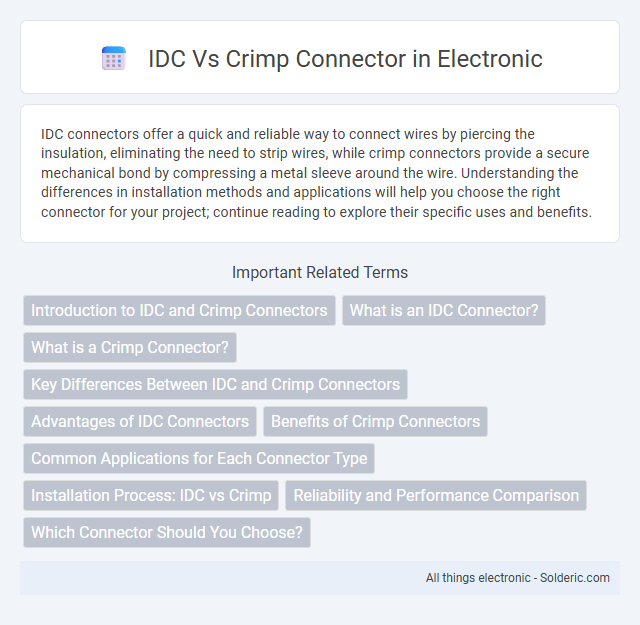IDC connectors offer a quick and reliable way to connect wires by piercing the insulation, eliminating the need to strip wires, while crimp connectors provide a secure mechanical bond by compressing a metal sleeve around the wire. Understanding the differences in installation methods and applications will help you choose the right connector for your project; continue reading to explore their specific uses and benefits.
Comparison Table
| Feature | IDC Connector | Crimp Connector |
|---|---|---|
| Connection Method | Insulation Displacement Contact, no wire stripping needed | Metal sleeve compression via crimping tool |
| Installation Speed | Fast, tool-assisted pressing | Moderate, requires precise crimping |
| Reliability | Reliable but sensitive to cable type and alignment | Highly reliable, strong mechanical bond |
| Application | Ribbon cables, flat cables, telecommunications | Single wires, automotive, industrial, and electronics |
| Cost | Lower cost connector, minimal prep | Higher cost due to tools and connectors |
| Tool Requirement | IDC insertion tool or simple press | Crimping tool required |
| Wire Preparation | No stripping needed | Wire stripping required |
| Durability | Moderate, prone to stress damage if mishandled | High, strong mechanical and electrical stability |
Introduction to IDC and Crimp Connectors
IDC (Insulation Displacement Connector) and Crimp Connectors are widely used in electrical and electronic wiring for efficient cable termination. IDC connectors allow quick connections by pushing wires into slots that slice through insulation without stripping, ensuring firm contact; Crimp connectors require a crimping tool to compress a metal sleeve onto the wire, creating a secure mechanical and electrical bond. Your choice depends on the application needs for speed, reliability, and tool availability in wiring projects.
What is an IDC Connector?
An IDC connector, or Insulation Displacement Connector, is a type of electrical connector designed to rapidly connect insulated wires without stripping the insulation. It uses sharp metal blades that pierce the insulation to make contact with the conductor inside, providing a reliable and consistent connection. Your choice of IDC connectors offers efficient mass termination in wiring harnesses and telecommunications.
What is a Crimp Connector?
A crimp connector is a type of electrical connector that securely attaches a wire to a terminal using a mechanical deformation process known as crimping. This method involves compressing a metal sleeve around the wire and connector, creating a reliable, low-resistance electrical connection without soldering. Crimp connectors are widely used in automotive, telecommunications, and industrial applications for quick, durable, and vibration-resistant terminations.
Key Differences Between IDC and Crimp Connectors
IDC connectors use insulation displacement technology to establish a secure connection by piercing the wire insulation, enabling quick and reliable terminations without stripping. Crimp connectors rely on compressing a metal sleeve onto the wire using a crimping tool, providing a strong mechanical and electrical bond suitable for various wire gauges. Understanding these key differences helps you select the appropriate connector for your project's requirements, ensuring optimal performance and ease of installation.
Advantages of IDC Connectors
IDC connectors offer several advantages, including fast and reliable mass termination of wires without the need for stripping insulation. Their design ensures consistent electrical connections by displacing the insulation, providing excellent signal integrity and reducing assembly time. You benefit from improved efficiency and reduced labor costs compared to traditional crimp connectors, especially in high-volume applications.
Benefits of Crimp Connectors
Crimp connectors provide a reliable, vibration-resistant electrical connection essential for automotive and industrial applications. Their installation does not require soldering, reducing assembly time and improving consistency in mass production. These connectors also offer excellent conductivity and mechanical strength, ensuring long-lasting performance in harsh environments.
Common Applications for Each Connector Type
IDC connectors are commonly used in telecommunications, data networking, and computer systems for quick and reliable connections without the need for soldering. Crimp connectors are preferred in automotive, aerospace, and industrial equipment where strong, durable mechanical bonds are essential for high-vibration environments. Understanding your project's requirements helps determine whether IDC's speed and simplicity or crimp connectors' robustness are the best fit.
Installation Process: IDC vs Crimp
IDC connectors feature a quick installation process by piercing the insulation of wires without stripping, enabling faster and more reliable connections. Crimp connectors require manually stripping the wire insulation followed by using a crimping tool to secure the connector onto the wire, demanding more precision and time. IDC installation reduces labor costs and errors in high-volume environments compared to the more time-intensive crimp technique.
Reliability and Performance Comparison
IDC connectors offer quick and reliable termination without soldering, but their performance can degrade under repeated mechanical stress and environmental factors, leading to potential contact issues. Crimp connectors provide superior long-term reliability and electrical performance due to their robust metal-to-metal connection, minimizing resistance and enhancing signal integrity in demanding applications. In high-vibration or harsh environments, crimp connectors consistently outperform IDC connectors by maintaining stable connections and reducing failure rates.
Which Connector Should You Choose?
Selecting the right connector depends on your project's requirements for speed, reliability, and ease of installation. IDC connectors offer quick, tool-free connections ideal for mass termination and less complex wiring tasks, while crimp connectors provide durable, secure contacts suited for high-vibration environments and long-term performance. Consider your need for efficiency versus maximum electrical integrity to decide which connector best suits your application.
IDC vs Crimp Connector Infographic

 solderic.com
solderic.com